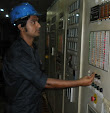Oil Mist Detector (OMD)
The oil mist detectors continuously extract the crankcase atmosphere via a pipe system and move it past a sensitive and accurate opacity measuring track. In the measuring track the opacity of the crankcase atmosphere is measured by means of infrared light.
In the monitoring mode OMD the crankcase atmosphere from all engines compartments simultaneously and feed it directly to the opacity measuring track for monitoring. The shortest possible response time after a rise in the concentration of the crankcase atmosphere is thus ensured.
The oil mist detectors mounted directly on the engine in order to keep the intake lines as short as possible to ensure minimum delay consist of-
- a base plate with air blast pump to generate the vacuum required to evacuate the crankcase atmosphere the built-in heating unit and a compact plug for electrical connection of the oil most detectors
- the interchangeable measuring unit containing the electronic system
The crankcase connection supplies the crankcase atmosphere to the oil mist detectors. Via crankcase connection the crankcase atmosphere is supplied to a separator in the base plate, where large oil particles are separated off with the aid of the centrifugal force. The oil separated off in the crankcase connection unit and the separator is directly ducted off via the oil ducts, to the air draft pump in the base plate and thus out of the unit so that it is not supplied to the opacity measuring track at all.
From the separator the sampled crankcase atmosphere is fed to the optical measuring track the measuring unit. In order to avoid soiling of the infrared filters by the crankcase atmosphere a certain amount of fresh air is continuously drawn in from the vicinity of the measuring unit via one air filter in each if the two so-called scavenging air chambers. This fresh air prevents the crankcase atmosphere from entering into contact with the infrared filters.
 |
| oil mist detector |
 |
| omd (inside the crankcase) |
Despite these measures the soiling of the infrared filters is still possible. The measuring track interprets this as an increase in opacity. The same effects in the measuring track are caused by the ageing and the possible temperature drift of the electronic components.
These changes are very slow to come about compared to the opacity rise in case of engine fault, consequently, their influence can be eliminated by adjusting the opacity reference point to take account of ageing, shilling etc. instead of keeping it constant as usual.
The adjustment of the reference value for opacity measuring is made so slowly that the sharp rise in opacity in case of fault is not overstepped.
In order to keep the oil mist detector ready for operation immediately after application of the supply voltage, a reference value, in which all the above-mentioned influences on the measuring track are instantly taken account of, is computed immediately after application of the operating voltage. This ensures that any basic opacity existing in the engine at the time the oil mist detector is activated is also reflected in the reference value.
Adjustment for the influences affected on the optical measuring track due to soiling and ageing can only be made to a certain point. If adjustment equals 70% opacity, the oil mist detectors will signal an equipment fault.
The entry of the fresh air into the scavenging air chamber is additionally used to verify whether a certain minimum vacuum required for the proper working of the oil mist detector exists in the measuring chamber.
In order to monitor the vacuum in the measuring chamber, a Pt 10c measuring sensor is fitted downstream of the two air filters; one sensor measures the flow rate; the other sensor measures the ambient temperature, to allow the necessary temperature compensation to be made.
After passing the optical measuring track, the crankcase atmosphere is fed to the air draft pump. The air leaving the air draft pump contains the crankcase atmosphere and leak oil from the separator and the crankcase connection unit and is fed to the bilge or the leak oil channel of the engine.
The optical measuring track includes an infrared light emitting diode generating a certain lighting intensity into an electrical signal which is fed to the electronic evaluation unit.
If the crankcase atmosphere contains oil mist, part of the infrared light is absorbed in the measuring track. As a result, the electrical signal is weakened. A higher opacity of the crankcase atmosphere will produce a lower electrical signal.
The electrical signal is mounted in the electronic evaluation unit for falling short of a minimum threshold value. This means for the opacity of the crankcase atmosphere that it is monitored for exceeding a maximum threshold value.
In the event of an oil mist alarm, the oil mist alarm relay picks up and the red alarm lamp is the windows blinks.
An oil mist alarm when occurred remains stored and can only be reset by pressing the reset key.
A green ready lamp indicates that the oil mist detector is in perfect working condition. At the same time ready relay is energized.
If the proper function of the oil mist detector is no longer assured, a comprehensive monitoring logic ensures that the ready lamp goes out and the ready relay drops off. An oil mist alarm is no longer transmitted, i.e. the oil mist relay fails to pick up and the red alarm lamp remains extinguished.







